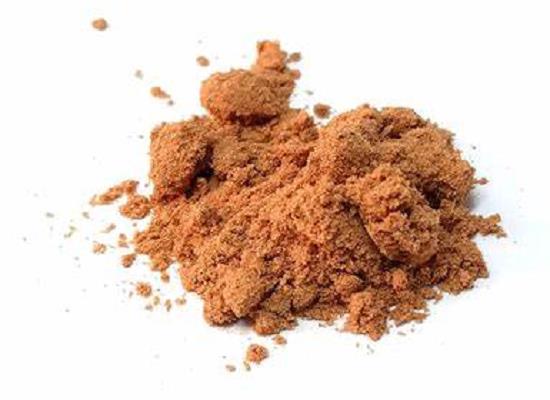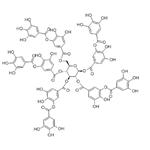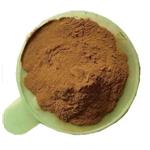Tannic Acid: A Potent Natural Compound for Anti-Inflammatory and Neuroprotective Effects
Jul 15,2024
General Description
Tannic acid exhibits potent anti-inflammatory activities, making it a valuable natural compound for managing various inflammatory conditions, including chronic diseases and skin inflammation. Additionally, tannic acid shows promising neuroprotective effects, particularly in mitigating oxidative stress and inflammation associated with neurodegenerative diseases like Alzheimer's and Parkinson's. Its ability to modulate key pathways involved in neuronal damage signifies its potential as a therapeutic agent for neuroprotection. Overall, tannic acid's dual actions in combating inflammation and protecting neural cells highlight its significance in medical and dermatological applications as a promising anti-inflammatory and neuroprotective compound.

Figure 1. Tannic acid
Anti-inflammatory Activities
Anti-inflammatory Actions
Tannic acid, a polyphenol found in many plants, has been increasingly recognized for its potent anti-inflammatory activities. This compound has historical roots in both Western and Eastern traditional medicine, primarily utilized for its therapeutic properties against various inflammatory conditions. The anti-inflammatory action of tannic acid is particularly notable in the context of chronic diseases, where inflammation plays a critical role in pathogenesis, including cancer, cardiovascular disease, and neurodegenerative disorders. Studies have demonstrated that tannic acid exerts significant anti-inflammatory effects, comparable to those of conventional medications such as indomethacin. For instance, in a formalin-induced paw edema model, tannic acid effectively reduced edema formation by inhibiting the activity of the myeloperoxidase (MPO) enzyme, a marker of inflammatory response. Despite the promising results, the precise molecular mechanisms underlying tannic acid's anti-inflammatory effects remain to be fully elucidated.
Skin Protection and Inflammation Management
Moreover, tannic acid has shown to have protective effects against environmental stressors, such as ultraviolet radiation (UV), which is known to provoke inflammation and contribute to skin aging and damage. In experiments involving hairless mice, tannic acid was found to mitigate UVB-induced damage by decreasing the activity of ornithine decarboxylase, an enzyme associated with UVB-stimulated DNA synthesis, and reducing the expression of proinflammatory cytokines like IL-18. These findings highlight tannic acid's potential in preventing the inflammatory responses associated with acute UV exposure and its implications in skin care, particularly in preventing photoaging and skin cancers. The anti-inflammatory properties of tannic acid extend beyond just acute interventions. Epidemiological data suggest that regular intake or topical application of tannic acid could play a preventive role in the onset of chronic inflammatory diseases and assist in the management of skin inflammation and injuries. This broad spectrum of benefits underscores the importance of tannic acid as a natural, effective anti-inflammatory agent in both medical and dermatological applications. 1
Neuroprotective Activity
Protective Effects in Neurodegenerative Diseases
Tannic acid is gaining recognition for its significant neuroprotective activities, particularly in the context of neurodegenerative diseases like Alzheimer's disease and Parkinson's disease, where oxidative stress and inflammation are major pathological drivers. This polyphenolic compound has been shown to provide a protective effect on neural cells largely due to its powerful antioxidant and anti-inflammatory properties. Research into the neuroprotective mechanisms of tannic acid reveals that it can modulate oxidative stress and inflammation, two critical factors in the progression of neurodegenerative conditions. For instance, studies involving models of cerebral ischemia, such as the middle cerebral artery occlusion in rats, have shown that tannic acid helps reduce behavioral deficits and neurodegeneration. It achieves this by diminishing oxidative stress and the inflammatory response within the brain, indicating a potent modulation of neuronal damage.
Mechanisms of Neuroprotection
Further insights into tannic acid's neuroprotective effect come from its impact on traumatic brain injury, where it significantly reduces behavioral impairments, oxidative damage, and inflammatory responses. This protection is likely associated with the activation of key signaling pathways, including PGC-1α and Nrf2/ARE, which are vital for cellular defense against oxidative stress and inflammation. Additionally, long-term treatment with tannic acid has demonstrated improvements in motor deficits and memory dysfunction in rat models of unilateral common carotid artery occlusion. Tannic acid's mechanism in these cases may involve the inhibition of apoptosis and cell death by bolstering antioxidant pathways, particularly through activation of the Nrf2 pathway, alongside the reduction of inflammatory factors. In summary, tannic acid's role in neuroprotection is multifaceted, targeting the intricate balance of oxidative and inflammatory pathways that contribute to neural damage. Its efficacy in reducing neural impairment and its potential therapeutic applications in neurodegenerative diseases underscore tannic acid's importance as a promising compound in the field of neuroprotection. 2
Reference
1. Jing W, Xiaolan C, Yu C, Feng Q, Haifeng Y. Pharmacological effects and mechanisms of tannic acid. Biomed Pharmacother. 2022; 154: 113561.
2. Halladin NL. Oxidative and inflammatory biomarkers of ischemia and reperfusion injuries. Dan Med J. 2015 Apr; 62(4): B5054.
- Related articles
- Related Qustion
- Tannins and Human Health Feb 17, 2022
“Tannin” was originally coined by Seguin:1. to describe the substances present in vegetable extracts, which are responsible for converting animal skin into leather.
α-Cyclodextrin (α-CD) is a cyclic oligosaccharide derived from corn.....
Jul 15,2024Biochemical EngineeringTannic acid
1401-55-4You may like
- Tannic acid
-

- $18.50 / 1kg
- 2024-07-15
- CAS:1401-55-4
- Min. Order: 1kg
- Purity: 99%
- Supply Ability: 5000kg
- Tannic acid
-

- $0.00 / 25Kg/Drum
- 2024-07-15
- CAS:1401-55-4
- Min. Order: 1KG
- Purity: 60%-98%
- Supply Ability: 5000mt/year
- Tannic acid
-

- $6.00/ kg
- 2024-07-11
- CAS:1401-55-4
- Min. Order: 1kg
- Purity: 99.99%
- Supply Ability: 10 tons




